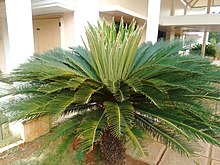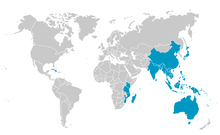
Back سيكاس Arabic سيكاد ARZ Saqo Azerbaijani সাইকাস Bengali/Bangla Cycas BS Cycas CEB Cykas Czech Cykas Danish Sagopalmfarne German Cikaso Esperanto
| Cycas Temporal range:
| |
|---|---|

| |
| A large cycas under development | |
| Scientific classification | |
| Kingdom: | Plantae |
| Clade: | Tracheophytes |
| Clade: | Gymnospermae |
| Division: | Cycadophyta |
| Class: | Cycadopsida |
| Order: | Cycadales |
| Suborder: | Cycadineae |
| Family: | Cycadaceae Pers.[2] |
| Genus: | Cycas L.[1] |
| Type species | |
| C. circinalis[1] L.[1]
| |

| |
| Synonyms[3] | |
| |
Cycas is a genus of cycad, and the only genus in the family Cycadaceae with all other genera of cycad being divided between the Stangeriaceae and Zamiaceae families. Cycas circinalis, a species endemic to India, was the first cycad species to be described in western literature, and is the type species of the genus.[4][5]
As of April 2024, there are 119 accepted species within the genus Cycas, all of which are native to Asia, Oceania, and eastern Africa and the Indian ocean region, with the largest number of species native to Australia, China and Vietnam.[6][7][8]
In horticulture, the most widely grown and perhaps best-known Cycas species is Cycas revoluta, which is commercially grown in large numbers for sale as houseplants or to be used in landscaping.[8][9][10]
As with other cycads in general, Cycas species may be popularly called 'living fossils', representing the surviving decedents of an ancient lineage of seed-bearing plants that were known to exist in the dinosaur era. Despite their ancient roots, the majority of Cycas species are highly endangered. Many are threatened by the illegal trade of wild collected plants for plant collectors, and through the conversion of land for urban development or agricultural use.[8]
- ^ a b c Hill, Ken; Leonie Stanberg; Dennis Stevenson. "The Cycad Pages". Genus Cycas. Royal Botanic Gardens Sydney. Archived from the original on 2021-03-01. Retrieved 6 September 2013.
- ^ Kramer, K.U.; Green, P.S., eds. (1990). Pteridophytes and Gymnosperms (PDF). The families and genera of vascular plants. Vol. 1. Assisted by E. Götz (illustrations). Berlin: Springer-Verlag. p. 370. ISBN 978-3-540-51794-8.
- ^ Cite error: The named reference
POWOwas invoked but never defined (see the help page). - ^ Linnaeus, Carl (1753). Palmae Pennatifoliae. Cycas [Cycas circinalis protologue]. pp. Sp. Pl. 2 : 1188.
- ^ Type Location(s): LT:t. 19, in Rheede, Hort. Malab, 3 (1682) Cycas circinalis at The World List of Cycads (cycadlist.org)
- ^ 119 accepted species, with 6 infraspecific taxa, as of April 21, 2024.
- ^ The World List of Cycads (WLoC), a comprehensive taxonomic reference for cycad taxonomy, nomenclature, biology, and literature. The WLoC is produced under the auspices of the IUCN/SSC Cycad Specialist Group (CSG). The online edition is hosted and sponsored by Montgomery Botanical Center. Calonje M, Stevenson DW, Osborne R. The World List of Cycads, online edition [Internet]. 2013-2024. [cited 2024 Apr 21]. Available from: http://www.cycadlist.org.
- ^ a b c Donaldson, J.S.; Dehgan, B.; Vovides, A.P.; Tang, W. (2003). "Cycads in trade and sustainable use of cycad populations" (PDF). Cycads status survey and conservation action plan. IUCN The World Conservation Union Gland, Switzerland.
- ^ "Cycas revoluta". cycadlist.org. Retrieved 2024-04-21.
- ^ Marler, Thomas E.; Moore, Aubrey (2010-05-01). "Cryptic Scale Infestations on Cycas revoluta Facilitate Scale Invasions". HortScience. 45 (5): 837–839. doi:10.21273/HORTSCI.45.5.837. ISSN 0018-5345.
© MMXXIII Rich X Search. We shall prevail. All rights reserved. Rich X Search